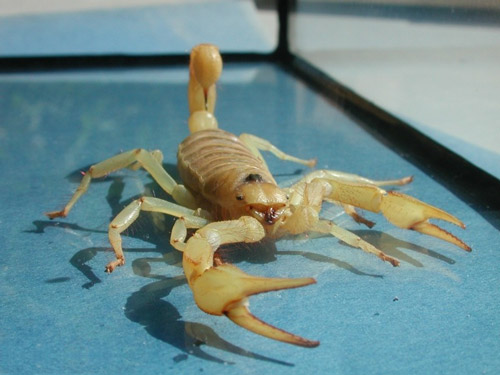The Giant Desert Hairy Scorpion is the largest scorpion in North America, reaching lengths of 6 inches. Their bodies are brown, with yellowish pinchers (pedipalps) and legs. Their common name comes from the brown hairs that cover their bodies. These hairs are used to detect ground and air vibrations. They have a long tail (telson) that is tipped with a bulb-like poison gland and stinger as well as large pinchers (chelae) and four pairs of legs.
Although a common pet species, these scorpions are considered aggressive and will sting frequently. Although the sting is painful, its venom is considered mild and has little effect on most humans. As with all stings, medical attention should be sought if the victim shows signs of allergic reactions, such as breathing difficulty, excessive swelling, or prolonged pain.
Commonly thought to be insects, scorpions are actually in the same family as spiders, ticks, and mites. Like all scorpions, they fluoresce a greenish blue under black (UV) lights.
Food
Mostly small desert insects and other invertebrates (lacking a backbone.) They will occasionally feed on small vertebrates (having a backbone,) such as baby lizards. Captive scorpions usually subsist on small insects such as crickets.
Habitat

These scorpions live in desert regions of California and Arizona (the name arizonensis loosely translates to ‘belonging to Arizona,’) and extreme southern Utah and Nevada. They are able to withstand extremely hot regions because they are nocturnal (active at night.) Rocks are frequently utilized as retreats from the heat of the day.
Predators
Birds, bats, small mammals, large spiders, centipedes, and lizards prey upon scorpions.
Social Structure
Scorpions are nocturnal (active at night) and lie in wait to ambush their prey. When a suitable victim wanders by, the scorpion grabs the doomed creature with its pinchers and stings the prey. After the prey is immobilized, the scorpion tears the carcass apart with its pinchers and begins feeding.
Birth & Offspring
Scorpions engage in an elaborate dance where the male grasps the female’s pinchers and moves around attempting to find a suitable location to deposit his sperm sack. Once the sperm is deposited, the male will maneuver the female over to the spot, where she will receive the sperm. After mating, the male will attempt a quick retreat but is often caught and consumed by the larger female. As with all scorpions, the Giant Desert Hairy Scorpion bears its young life. The infant scorpions live on the mother’s back for around a week before going out on their own.
Senses
All scorpions have poor eyesight, good hearing, and a good sense of touch. Body hairs are used to detect air and ground vibrations.

Lydia King is a huge animal lover and has always been fascinated with learning about the animal kingdom. She enjoys writing about anything animal related from scientific information about rare species to animal references in pop culture.












